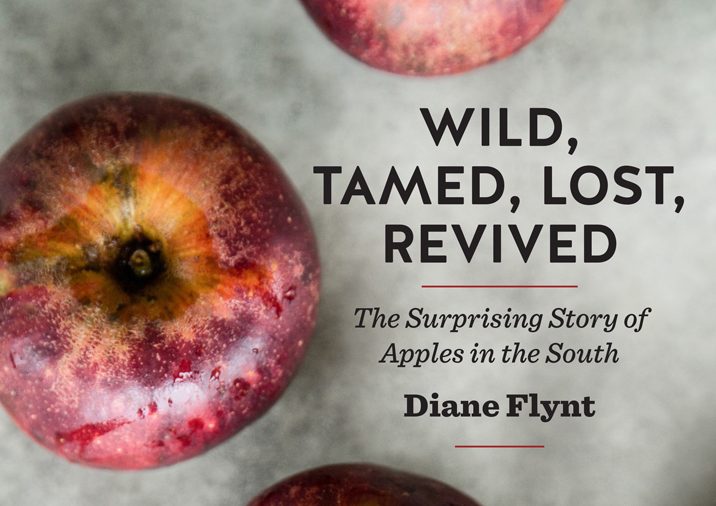When Diane Flynt signs onto a Zoom call from her home in southwest Virginia, the connection is spotty at first. That’s a tradeoff of rural living that she gladly accepts. Sporting a college-style sweatshirt reading KALE, she radiates a love for the land around her and what it can produce—a love that permeates her new book, Wild, Tamed, Lost, Revived: The Surprising Story of Apples in the South.
“Behind each knobby brown orb, underneath every quirky apple name or sprightly flavor, lies a person, culture, and history. And nowhere is this history more interesting than in the South,” she writes in the book’s introduction.
Flynt would know. In 1995, she bought a farm near Floyd, Virginia, and planted an orchard with the goal of becoming the state’s first cidermaker. “She was the one who started the industry in Virginia,” says Mary Godinez, who co-owns an Augusta County fruit tree nursery and has known Flynt for nearly a decade.
Flynt spent years dividing her time between the farm and a corporate career, but eventually her Foggy Ridge cider became a full-time vocation and a widely distributed craft cider brand. Her book recounts this journey in vivid detail—pruning trees, tasting cider blends, spotting wildlife. Like when, “pruning saw in hand … I came face to face with a tiny hummingbird nest hidden in a tangle of apple branches.”

Flynt also traveled relentlessly to build the business and spread the gospel of craft cider—a drink more akin to wine than beer, with every vintage a unique reflection of that year’s weather and that orchard’s terroir. If craft cider celebrates diversity, Flynt’s book is a record of the grand assortment of apples that once existed in the South.
“It’s clear that all Southerners grew and grafted apples, chose and named apples,” she says—“close to 2,000 varieties. The Southern-spawned apples were not just presidential, they were from everybody.” Though founding fathers are associated with certain well-documented varieties, Flynt is more interested in the everyday people—including Native Americans and enslaved Black workers—who contributed to apple culture in the South.
“What we don’t know about the past is as important as what we do know. I wanted to look at those blank spaces,” she says. “The history is the history—often, of privilege—the educated, people who could write, had access to having things published or had families that could preserve papers, and that’s not everybody.” She writes, for example, of Jarvis Van Buren, a white man who traveled into what had been Cherokee country in the Georgia mountains, after the Indigenous nation had been forced out. Van Buren collected fruit and grafting wood from abandoned Cherokee orchards and used these to found a nursery staffed by enslaved workers, “integrat[ing] stolen Cherokee apples into mainstream Southern agriculture, their wildness diluted, their Indigenous names disappeared, their history muted.”
All over the East, the 19th century saw an explosion of apple varieties being named and traded. But the vibrant Southern apple culture was always given short shrift by Northern writers and horticulturists. One 1845 reference, The Fruits and Fruit Trees of America, mentioned only one Southern apple. “Patrick Barry’s book The Fruit Garden, from 1851, had 133 apples, and I think only three or four Southern apples,” says Flynt. “There just wasn’t the awareness.”
The golden age was not to last; interestingly, slavery in the South may have indirectly contributed to the ultimate decline of the Southern apple. The founder of the Northwestern apple industry, Henderson Luelling, moved west from his native North Carolina in the 1820s because his Quaker family were committed abolitionists. He hopped from state to state before landing in Oregon and starting a commercial nursery. “As it turned out,” Flynt writes with understatement, “apples grew very well in the Pacific Northwest.”
Apples and the foodways around them had woven themselves into many aspects of history—including local history. The Blue Ridge Parkway and Shenandoah National Park displaced mountain communities where families once grew apples for brandy and food, drying them on cabin roofs. The Dickie Bros. Orchard in Nelson County developed a variety named after the peak that overlooks the orchard, Priest Mountain (Pride of Du Priest, later shortened to Pride of Du Pres). And of course, the Albemarle Pippin enjoyed an international reputation.
But the ascendancy of the new Northwestern industry, plus technological changes like rail transport, pushed Southern apples into decline and favored the rise of more standardized, shelf-stable varieties—think Red Delicious—at the expense of the older, quirkier types. (The names of those varieties are a treat in themselves: Taliaferro, Limbertwig, Grimes Golden, Early Strawberry.)
As for Flynt, she eventually decided to give up cider making and focus on growing apples—and on writing. “I’m sorry she stopped making cider,” Godinez says of Flynt, whom she sees as an expert ambassador for artisan cider in a market flooded with mass-produced beverages. Yet the book is lovingly crafted, just like a small-batch cider; Flynt’s personal story brings a terroir to the book that enlivens the meticulously researched history.
“Now that I’m out talking to people about the book,” she says, “I see it in new ways. So many people say, ‘I love that memoir.’”
